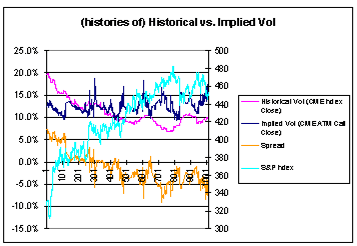Last year, the Securities and Exchange Commission announced it would allow companies to choose between three different methods to fulfill market risk disclosure requirements. Derivatives users could choose between tables of individual risk factor data, sensitivity analyses or value-at-risk-type information.
Which method will companies be using to fulfill these requirements? According to a January 1998 survey of some 30 financial firms and corporations by Capital Market Risk Advisors, 80 percent of the respondents indicated their disclosure methods would involve techniques similar to those they already use for internal risk measurement and reporting.
Most banks and broker-dealers already use value-at-risk internally to measure the risk of their trading activities, and most of these plan to use VAR to disclose the market risk of trading activities to the SEC, though they may not use VAR in disclosing nontrading activities.
The majority of insurance companies surveyed, meanwhile, use sensitivity analysis to meet regulatory reporting requirements, and most of these plan to use the technique to meet SEC requirements.
By contrast, most of the smaller firms that do not currently use VAR plan to use tables of individual risk factor data to comply with the SEC requirements.
The survey discovered a number of interesting VAR-related factoids:
Which method will companies be using to fulfill these requirements? According to a January 1998 survey of some 30 financial firms and corporations by Capital Market Risk Advisors, 80 percent of the respondents indicated their disclosure methods would involve techniques similar to those they already use for internal risk measurement and reporting.
Most banks and broker-dealers already use value-at-risk internally to measure the risk of their trading activities, and most of these plan to use VAR to disclose the market risk of trading activities to the SEC, though they may not use VAR in disclosing nontrading activities.
The majority of insurance companies surveyed, meanwhile, use sensitivity analysis to meet regulatory reporting requirements, and most of these plan to use the technique to meet SEC requirements.
By contrast, most of the smaller firms that do not currently use VAR plan to use tables of individual risk factor data to comply with the SEC requirements.
The survey discovered a number of interesting VAR-related factoids:
- The length of the observation period used in the calculations will range from less than one year to more than three years.
- The amount of VAR generally represented less than 1 percent of the respondents’ book values among broker-dealers and banks that offered their 1997 statistics.
- More than 90 percent of these plan to use VAR calculations for pricing models rather than for concrete changes in earnings, values or cash flows.
- The most common model is the analytic variance-covariance VAR, with aproximately 50 percent selecting this method by itself. Most cited the less computationally intensive nature of this calculation relative to historical VAR (20 percent of respondents), Monte Carlo-based VAR (25 percent) or other stimulation methods (5 percent).
- Twenty percent of the VAR-using firms ignore nonlinearity positions altogether, while 25 percent of the respondents made adjustments for option holdings by measuring the delta of their positions. Another 30 percent made adjustments using both delta and gamma.
- In general, those firms using VAR take into account the correlation effects across risk exposures both within and across instrument types. For about 90 percent of the respondents, use of empirical correlations is the preferred methodology.
- All of the bank and broker-dealer respondents plan to use a one-day holding period, while insurance companies and corporates plan to use periods of two weeks to one year.
- Of the firms that plan to use sensitivity analysis, all plan to use actual, observed fair values rather than pricing model computations. Unlike the VAR-using firms that account for volatility and correlation, sensitivity analysis-using firms plan to show the sensitivity only to price changes and market factors such as currency rate or interest rate changes.



